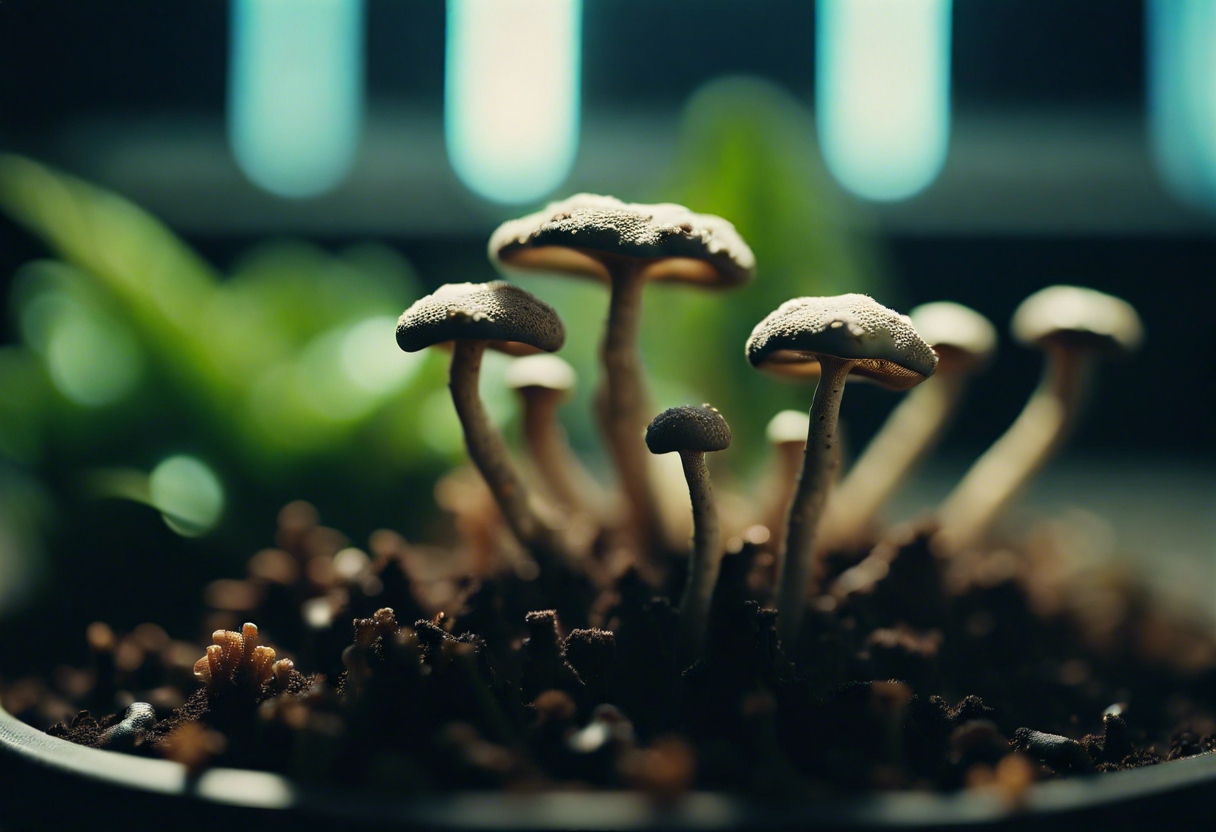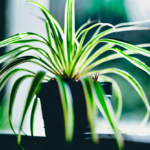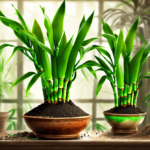Understanding Indoor Plant Soil Fungus: What You Need to Know
Indoor plant soil fungus is a common issue that many plant enthusiasts encounter. It refers to the growth of fungal colonies in the soil of indoor plants, which can have detrimental effects on their overall health and vitality. Fungus thrives in damp, humid conditions, making indoor plant soil an ideal breeding ground. Understanding the causes, types, and treatment options for indoor plant soil fungus is crucial in maintaining the well-being of your beloved plants.
There are several common types of indoor plant soil fungus that gardeners may come across. One such type is powdery mildew, which appears as a white or grayish powdery coating on the leaves and stems of plants. Another commonly encountered fungus is the black sooty mold, characterized by the presence of a dark, velvety layer on the foliage. Additionally, root rot is a prevalent soil fungus that affects the roots of plants, leading to stunted growth and eventual wilting.
Several factors contribute to the growth of indoor plant soil fungus. Overwatering is a prime culprit as excessive moisture creates a favorable environment for fungal growth. Poor drainage, inadequate air circulation, and lack of sunlight can also contribute to the problem. Additionally, using contaminated soil or pots, and the presence of decaying organic matter can introduce fungal spores into the soil, initiating the growth of indoor plant soil fungus.
Identifying the symptoms of indoor plant soil fungus is essential for timely intervention. In the case of powdery mildew, white, powdery patches on leaves and stems are an unmistakable sign. Black sooty mold manifests as a dark layer on the foliage, often accompanied by a sticky residue. Root rot, on the other hand, reveals itself through discolored, mushy roots and a foul odor. Regularly inspecting plants for any signs of fungal growth enables prompt action and prevents further damage.
Prevention is key when it comes to managing indoor plant soil fungus. Firstly, ensure proper drainage by using pots with drainage holes and well-draining soil. Water plants appropriately, avoiding excessive moisture. Adequate air circulation and sunlight can create an unfavorable environment for fungus growth. Regularly clean and sanitize pots, tools, and surfaces to prevent the spread of fungal spores. Moreover, removing any decaying organic matter and promptly addressing any plant stressors can significantly reduce the risk of indoor plant soil fungus.
Treatment options for indoor plant soil fungus focus on eliminating the existing fungal colonies and preventing reoccurrence. Pruning affected plant parts, such as leaves and stems, can help control powdery mildew and black sooty mold. Applying a homemade solution of water and neem oil can also be effective against these fungal infections. For root rot, it is crucial to act promptly by removing the affected plant from the soil, washing the roots, and repotting it in fresh, sterile soil.
Indoor plant soil fungus poses a significant threat to the health and vitality of indoor plants. Understanding the causes, symptoms, prevention, and treatment options for this issue is crucial for maintaining thriving plants. By taking appropriate measures to prevent fungal growth, coupled with timely intervention when necessary, you can ensure that your indoor plants remain vibrant and free from soil fungus. Remember to regularly inspect your plants, provide optimal growing conditions, and implement proper sanitation practices to keep indoor plant soil fungus at bay.
Common Types of Indoor Plant Soil Fungus
When it comes to indoor plants, one common issue that plant owners may encounter is the presence of soil fungus. Fungi are microscopic organisms that thrive in warm, humid environments and can cause various problems for indoor plants. Understanding the different types of indoor plant soil fungus can help you identify and address the issue promptly.
One of the most prevalent types of indoor plant soil fungus is powdery mildew. This fungal disease appears as a powdery white or gray substance on the leaves, stems, and flowers of plants. Powdery mildew is spread through airborne spores and can result in stunted growth, leaf yellowing, and even plant death if left untreated.
Another common indoor plant soil fungus is root rot. This fungal infection typically occurs when the soil remains consistently wet or over watered. It affects the roots, causing them to turn dark and mushy, inhibiting the plant’s ability to absorb nutrients and water properly. Plants affected by root rot often exhibit wilting, yellowing leaves and may eventually die if not treated promptly.
Damping-off is a type of soil fungus that primarily affects seedlings. It causes the young plants to topple over and decay at the soil line, preventing them from maturing into healthy plants. Damping-off can be caused by various types of fungi, and it typically thrives in moist soil conditions.
Botrytis blight, also known as gray mold, is another indoor plant soil fungus that can quickly spread and infect a wide range of plant species. This fungal disease manifests as grayish-brown patches on leaves, stems, flowers, and fruits. Botrytis blight thrives in cool and wet conditions, making it a common issue in indoor environments with high humidity.
Fusarium wilt is a soil-borne fungus that affects the vascular system of plants. This fungal disease gradually blocks the plant’s ability to transport water and nutrients, ultimately leading to wilting, yellowing leaves, and plant death. Fusarium wilt is often transmitted through contaminated soil or infected plant debris.
To prevent and address indoor plant soil fungus, it is crucial to maintain proper plant care practices. Ensure proper drainage by using well-draining soil mixes, avoiding overwatering, and providing adequate air circulation. Regularly inspect your plants for any signs of fungal infections and promptly remove and dispose of affected plant parts. organic fungicides that are safe for indoor use can also help control the spread of soil fungus.
Remember, early detection and proactive measures are key to effectively managing indoor plant soil fungus. By understanding the common types of soil fungus and implementing proper preventive measures, you can enjoy healthy and thriving indoor plants.
Causes and Risk Factors for Indoor Plant Soil Fungus Growth
Indoor plant soil fungus can be a persistent and frustrating problem for plant enthusiasts. Understanding the causes and risk factors associated with its growth is essential in preventing and managing this issue effectively.
One of the primary causes of indoor plant soil fungus growth is excessive moisture. When the soil is consistently wet or overwatered, it creates an ideal environment for fungi to thrive. Overwatering not only creates a favorable breeding ground for fungi but also weakens the plant’s roots, making it more susceptible to infection.
Poor drainage is another factor that contributes to indoor plant soil fungus growth. When pots lack drainage holes or have insufficient drainage, excess water accumulates in the soil, promoting fungal growth. It is crucial to ensure that your plant pots have adequate drainage to prevent waterlogged conditions.
Using contaminated potting soil can introduce fungal spores into your indoor plants’ environment. When purchasing soil or reusing old soil, it is essential to check that it is free from any signs of fungal growth. Additionally, contaminated gardening tools, such as shovels or trowels, can also introduce fungal spores to the soil, leading to potential infections.
Indoor plant soil fungus growth can also be attributed to poor air circulation. Lack of proper ventilation around the plant’s foliage and soil prevents moisture from evaporating and creates a moist environment conducive to fungal growth. It is important to ensure adequate airflow by placing indoor plants in areas with good ventilation or using fans to improve air circulation.
Certain environmental conditions increase the risk of indoor plant soil fungus growth. High humidity levels, especially in closed spaces, contribute to the development of fungal infections. Areas with inadequate sunlight or low light conditions can also weaken plants, making them more susceptible to fungal attack. Additionally, fluctuations in temperature and extreme heat can stress plants, compromising their immune system and making them more susceptible to fungal infections.
To minimize the risk of indoor plant soil fungus growth, it is crucial to adopt preventive measures. First and foremost, ensure proper watering practices, allowing the soil to dry out between waterings. Providing adequate drainage by using pots with drainage holes or adding gravel at the bottom of the pot can help prevent waterlogging. It is also essential to use fresh and sterilized potting soil and regularly clean and disinfect gardening tools to prevent the introduction of fungal spores.
Maintaining good airflow and ventilation around your indoor plants is crucial in preventing fungal growth. Place plants in areas with sufficient sunlight and avoid overcrowding them. When necessary, consider using a small fan to improve air circulation.
Understanding the causes and risk factors associated with indoor plant soil fungus growth is essential in preventing and managing this issue effectively. By implementing preventive measures such as proper watering, drainage, and ensuring good airflow, you can create an environment that discourages fungal infections and promotes the healthy growth of your indoor plants.
Identifying Indoor Plant Soil Fungus: Symptoms and Solutions
Indoor plants bring nature’s beauty into our homes, but unfortunately, they are also susceptible to various problems, including soil fungus. Indoor plant soil fungus refers to the growth of harmful fungi in the soil, which can negatively affect the health and growth of your plants. It is essential to identify the symptoms of soil fungus early on to prevent further damage. In this article, we will discuss the symptoms of indoor plant soil fungus and provide effective solutions for its treatment.
One of the most common symptoms of indoor plant soil fungus is the appearance of mold or mildew on the soil surface. These fungi thrive in warm, damp conditions, and their presence can be seen as a fuzzy or powdery layer on the soil. Another visible sign of soil fungus is the formation of white or brown spots on the leaves of the affected plants. These spots may gradually enlarge and can lead to leaf discoloration and decay.
In addition to the visual symptoms, indoor plant soil fungus can also cause noticeable changes in the plant’s overall health. Infected plants may exhibit stunted growth, wilting, or a general decline in vigor. Fungal infections can weaken the plant’s roots, making it more susceptible to other diseases and environmental stressors. If left untreated, soil fungus can eventually lead to the death of the plant.
To effectively treat indoor plant soil fungus, it is crucial to address the underlying causes. One of the main contributors to fungal growth is overwatering. Excessive moisture creates the perfect breeding ground for fungi. Therefore, it is essential to establish a proper watering routine for your indoor plants. Allow the soil to dry out slightly between waterings, and avoid leaving standing water in saucers or trays.
Improving air circulation around your plants can also help prevent soil fungus. Adequate airflow helps to dry out the soil’s surface, making it less favorable for fungal growth. You can achieve this by placing a small fan near your indoor plants or by periodically opening windows to increase ventilation.
Another effective solution for indoor plant soil fungus is the use of organic fungicides. These natural products help to suppress fungal growth without harming the plant or the environment. Look for fungicides that contain beneficial bacteria or fungi, such as Bacillus subtilis or Trichoderma, which can outcompete and control harmful fungi.
Regularly inspecting and maintaining your indoor plants is crucial for preventing and treating soil fungus. Remove any infected leaves or plant debris promptly to prevent the spread of the fungus. Consider repotting your plants using fresh, sterile potting soil if the fungus persists. Additionally, avoid overcrowding your plants, as this can contribute to the development and spread of fungal infections.
Indoor plant soil fungus can be a challenging problem to tackle, but with early identification and proper treatment, it can be controlled. By being mindful of watering practices, improving air circulation, and using organic fungicides, you can provide a healthy environment for your indoor plants. Regular care and maintenance are key to preventing the growth of soil fungus and ensuring the longevity and vitality of your beloved indoor greenery.
Prevention and Treatment Options for Indoor Plant Soil Fungus
Indoor plant soil fungus can be a common issue for many plant lovers. However, there are several prevention and treatment options available to help combat this problem and maintain the health of your indoor plants.
One of the key aspects of preventing indoor plant soil fungus is proper moisture control. Overwatering plants can create a damp environment that promotes fungal growth. To prevent this, make sure to water your plants in moderation and allow the soil to dry out slightly between watering sessions. Additionally, avoid using saucers under pots as they can trap excess moisture.
Another preventive measure is to improve air circulation around your plants. Fungus thrives in stagnant air, so providing adequate ventilation can help reduce the chances of fungal growth. You can achieve this by placing fans near your plants or simply opening windows to allow fresh air to circulate.
Using well-draining soil is another crucial step in preventing indoor plant soil fungus. Fungal spores are present in many types of soil, but they are less likely to germinate and grow in well-draining soil. Consider using a high-quality potting mix that is specifically designed for indoor plants. These mixes usually include amendments such as perlite or vermiculite, which help improve drainage.
When it comes to treating indoor plant soil fungus, there are a few options available. One effective method is to remove the affected soil from the pot, gently wash the roots, and replant your plant in fresh, sterilized soil. This helps to eliminate the source of the fungus and gives your plant a fresh start. Be sure to discard the contaminated soil properly to prevent spreading the fungus to other plants.
Fungicides can also be used as a treatment for indoor plant soil fungus. There are several types of fungicides available, ranging from chemical-based to organic options. It is important to read and follow the instructions provided by the manufacturer when using fungicides, as improper use can be harmful to your plants.
In addition to prevention and treatment options, it is important to regularly monitor your indoor plants for any signs of fungal growth. Keeping a close eye on your plants allows you to catch any issues early on and take appropriate action. If you notice any discolored or wilting leaves, white or brown fuzz on the soil surface, or a musty odor, it may indicate the presence of indoor plant soil fungus.
Preventing indoor plant soil fungus is crucial for maintaining healthy indoor plants. By controlling moisture, improving air circulation, using well-draining soil, and monitoring your plants closely, you can minimize the risk of fungal growth. If fungus does occur, treatments such as removing affected soil and using fungicides can help eliminate the problem. With proper care and attention, you can enjoy thriving indoor plants free from soil fungus.
Conclusion
Indoor plant soil fungus refers to the growth of fungal organisms in the soil of indoor plants. There are several common types of indoor plant soil fungus, including white mold, root rot, and powdery mildew. These fungi thrive in moist and poorly ventilated environments, making them a common problem for indoor plants.
The causes of indoor plant soil fungus growth can vary, but they often result from overwatering, poor drainage, and lack of air circulation. Additionally, contaminated potting soil or infected plant material can introduce fungus into the indoor environment. Reduced light levels and high humidity also create favorable conditions for fungal growth.
Identifying indoor plant soil fungus can be done by observing several telltale symptoms. These include discolored or wilting leaves, stunted growth, foul odors, and the presence of white, fuzzy, or powdery substances on the soil surface or plant leaves. Taking note of these signs and symptoms is crucial in recognizing the presence of indoor plant soil fungus and addressing it promptly.
Preventing indoor plant soil fungus is essential for maintaining healthy and thriving indoor plants. This can be achieved by practicing proper watering techniques, such as allowing the soil to dry out between waterings and avoiding waterlogging. Adequate drainage is also crucial, so ensure there are drainage holes in the pots and consider using a well-draining potting mix. Improving air circulation around the plants by using fans or opening windows can also discourage fungal growth.
In the event that indoor plant soil fungus is already present, various treatment options can be implemented. For localized fungal infections, removing and disposing of the affected plant parts can help stop the spread. In more severe cases, treating the soil with fungicides specifically formulated for indoor plants may be necessary. These fungicides can help eliminate the fungus and prevent reoccurrence, but it’s essential to follow the instructions and precautions provided by the manufacturer.
Regular maintenance practices like cleaning and sterilizing gardening tools, pots, and trays can also help prevent the spread of indoor plant soil fungus. Additionally, quarantining new plants and inspecting them for any signs of fungal infection before introducing them to the indoor environment can help prevent the introduction of fungi.
By understanding the causes, symptoms, and prevention measures for indoor plant soil fungus, plant enthusiasts can effectively address and mitigate this common issue. With proper care, including the provision of adequate light, appropriate watering, and good air circulation, indoor plants can thrive and flourish, enhancing the beauty and air quality of the indoor environment.


